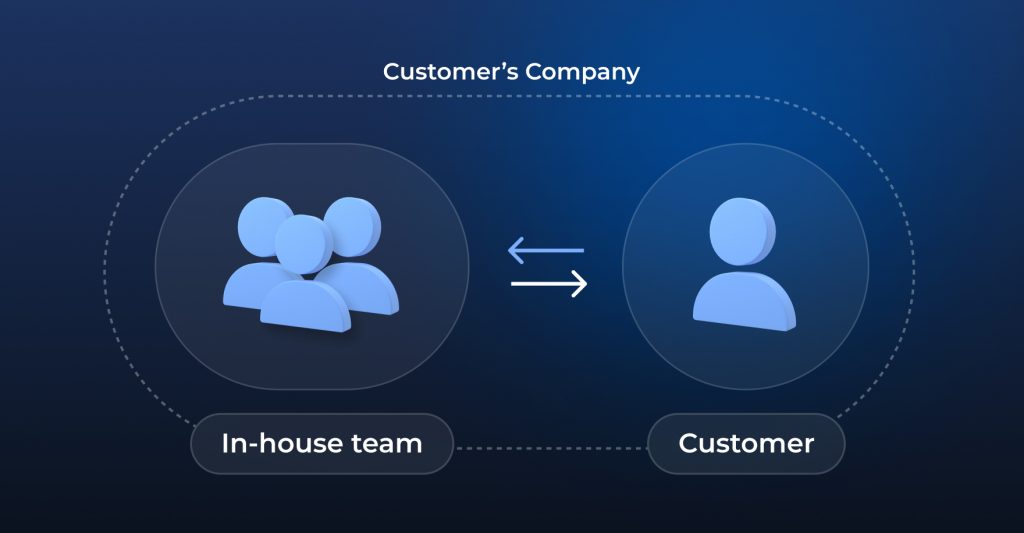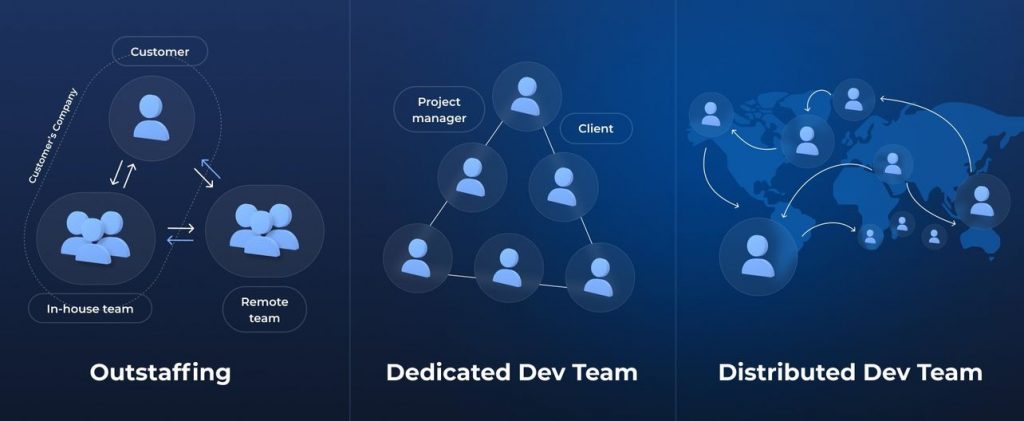Table of Contents
Remote software engineers face numerous issues working on outsourcing software projects. According to the latest statistics, among the top challenges predominate the following – unrealistic deadlines, tense relations with in-house developers and other teams within their company, no clear vision of the solution, and poor team management.
The last challenge is a common reason for all other difficulties stakeholders and software teams can struggle with, which can be resolved with the efficient management of software development teams in remote environments. By sharing this post, we would like to dive deeper into the challenges that you as a client can face working with the remote software development team and outline the best efficient practices of outsourcing team management based on Altamira’s experience.
In-house vs remote software development teams structure: pros & cons
Basically, cooperation with software developers doesn’t divide only black and white, meaning in-house and remote development teams. There are various team models and contracts that can be applied to your software projects according to your ongoing needs and requirements.
You may have an in-house software development team and augment it with remote developers, you can have only in-house developers or completely dedicate your software project to an outsourcing software provider. Therefore, we would like to discuss the pros and cons of different types of development teams to simplify your choice.
The in-house software development team
The title of this team structure speaks for itself. The in-house software development team entails hiring full-time developers for your business needs, including a business analyst and project manager.
This software development team structure is not really in demand these days, as businesses who cannot trust the entire development process outsourcing developers, create hybrid development teams which is a combination of inner developers and staffing developers that the in-house team is lacking to build the software project or support the existing solutions.
Let’s outline the advantages and disadvantages of this type of software development team, so you could decide whether this somehow suits your case.

Pros of the in-house software development team:
- Face-to-face communication – as in-house developers work for your company full-time, you can take part in the whole development process, monitor the project changes, and discuss them as soon as they are applied to the software solution the team builds; this simplifies the communication process overall ensuring its 100% transparency;
- You pick tech talents to hire – the recruiting process can be quite challenging, but you can interview each engineer on your own; however, there is still a risk that some candidates may not suit your demands after the probation period which forces searching again;
- Keeping an eye on the process – you become the participant in the software development process and can track the work effectiveness of your team, set deadlines, and manage literally everything, which can be exhausting even having a project manager.
Cons of the in-house software development team
- High expenses – an in-house team is needed for two main options – solution development and solution maintenance, where the maintenance part has a decreased scope of work; so you still need to provide your inner developers with monthly payments even if they are lacking tasks on the software project;
- Gaps in technical expertise – in-house developers are hired to supply the current needs of the project; hence, their skills and technical expertise can be not enough to scale the software in the future or start working on another type of software for your business needs; thus you will have to expand the team, which leads to higher costs to maintain the in-house software development team;
- Durable employee onboarding – when you expand your in-house team during the development process, it will take a certain amount of time to find reliable engineers and onboard them to the project and its specifics; the deadlines will probably be delayed as well the software delivery.
The remote software development team
Remote software development teams can be differentiated into several options. It can be augmented developers who will scale your in-house team, a distributed team that entails hiring developers from various companies and locations, and a dedicated software development team structure where all developers work as a single unit in the same software house.
Based on our experience, team augmentation and dedicated team are the most popular types of remote development teams. However, software providers also offer different contract types like fixed prices, time material, and dedicated team, where time & material is more beneficial as you pay only for the actual hours spent on your project, no more no less. When you pick the dedicated team, this type requires long-term commitment, and lower rates and this team is similar to the in-house team where you pay for work hours and vacations as well. And further, we would like to discuss why.

Pros of the remote software development team
- Access to a broad tech talent pool – remote software development team structure gives you full freedom to choose the engineers that will work on your software project – experience, technical skills, and knowledge; the only dependency is hourly rates you can afford;
- Hiring and onboarding are not your responsibility – remote developers are a quick and efficient way to supply your inner team as well as build a complete outsourcing team for your needs; the hiring and onboarding process relies on your software development partner;
- Cost-efficient solution – in case of cooperation with a remote software development team, you pay only for the actual house of work according to the initially approved hourly rate for each engineer; you don’t have to supply the team with all-year-round payments;
Cons of the remote development team
- Communication risk – the entire communication during the cooperation with the remote development team is conducted online, and the project manager of the outsourcing team is accountable for holding regular meetings and project updates up to your requirements;
- Project management gaps – remote software development means that you cannot control every single process on your own; thus, you are tasked with hiring a credible software development partner who is capable of providing transparent reporting and effective project management.
Challenges and solutions for managing software development teams in a remote environment
At this point, we would like to take a closer look at the potential challenges and complexities you may face when working with remote development teams structure. However, we have already figured out the solutions to each of them, as all these issues can be easily addressed by an experienced software provider.
Lacking management for remote developers
Project management is pivotal not just for you as the client to ensure everything is going well, but also for the remote developers. They need constant communication with the project manager in order to consult, check the project progress, etc. Let’s talk about augmented developers that your inner project manager manages. These specialists need to build a certain flow of communication with remote developers, tracking their tasks, assessing potential risks, and supporting them in case of need.
But if we view the dedicated software development team, for instance, then this remote team structure includes the project manager who is accountable for constantly managing the dedicated developer and connecting you and the team.
Unrealistic expectations about the work with a remote development team
Before starting any software project task, it is essential to ensure the client and the remote developers are on the same page. Clients who have never worked with remote teams should completely understand the specifics of this cooperation model.
For example, a developer needs to be aware of the business objectives of building the solution, know the expected ways and frequency of communications, and so on. It means that remote developers will not be able to respond to your messages every minute or hour, so we recommend organizing smooth communication and other organizational processes from the very beginning.
Low productivity of remote developers
Before the pandemic, we all faced the stereotype that people, who work from home and are invisible, don’t work productively compared with office workers. But times have changed and now the majority of software houses conduct all their processes and services online.
This challenge may appear if you pick the team augmentation service, where half of the inner developers always work from your office and the remote developers are always virtual.
However, it doesn’t determine the productivity or skills of these developers, only the successful results matter. By the way, the in-house developers were hired for full-time jobs, and it is up to business stakeholders whether they work from the office or home.
Communication gap
This is going to be the most common threat when talking about challenges with remote development teams. As we mentioned before, it is vital to create the communication flow before the development starts to avoid any misunderstandings.
Define the communication tools the client side and team side will use to chat and hold video meetings, choose the frequency of meetings according to the time zones of remote developers, decide on the project management software and forms of regular reports, etc. This flow has to be approved by both sides and adjusted in case of need.
Lack of team unity
If your software projects entail hybrid development when the in-house and remote need to unite, it is vital to treat both sides with the same attitude and benefits. Surely, your inner developers are your employees, and you cannot supply remote development with the same public holidays, vacations, and other benefits.
But the attitude needs to be fair and transparent for both parties so that each could feel valued and required on the project. It enables the motivation and overall productivity of software developers. There is no place for discord between inner and remote developers to end the development process successfully.
Augmented developers can feel isolated
Dedicated software development team models entail the smooth work of the entire team together, even being remote all the time. But when you hire outstaff developers, just 1 or 2 engineers, who are accountable for executing certain tasks of the project but don’t have access to the inner team and constant communication with other engineers, these specialists may feel isolated.
Then, the probability of burn-outs becomes much higher, as well as the probability of low productivity and mental state. So no matter what type of remote cooperation you pick, as a stakeholder you need to support all engineers on the same level, and hold interactions with the complete team.
7 tips on how to manage remote development teams
Communication has to be scheduled
As communication is at the top of risks according to client considerations, it is pivotal to set a communication flow that includes schedules, frequency, types, goals, tools, etc. It needs to be adjusted to client needs, not when the team thinks it is time.
Usually, communication with remote teams entails video meetings with the team to check the project progress, demo meetings, planning meetings, chats where the client can reach the team anytime needed, emailing, and so on. The client also needs access to a task tracker to ensure the complete transparency of the remote team.
Commonly, remote teams use Slack and Skype for smooth communication with clients in text messages and audio calls. For video calls, Google Meets or Microsoft Teams are two great options that set no limits to call duration and allow screen and document sharing.
Find advantages in different time zones
Different time zones provide no complexities in communication between the client and the remote team, or the in-house and remote teams. If the difference is not more than 3 hours, then the working hours of both sides coincide. If the difference is more like 8-9 hours, the meetings and smooth communication are still possible, but the remote software development team needs to adjust to the client’s capabilities.
Surely, if none variant fits your requirements, then the best choice for you would be looking for in-house developers or remote developers in the same time zone, whose hourly rate will not really differ from the in-house developers` payrolls.
Every team member needs to be aware of the clear vision
Onboarding of the team employees is the most pivotal step in successful cooperation and remote team management. Every developer and specialist involved in your software project has to be on the same page with your business goals and plans. It means that the remote development team has to learn your vision of the final software solution or product, its benefits for your business processes, and realistic expectations.
Remote engineers have to precisely understand their roles and responsibilities in this project, and tasks before the start of software project onboarding. However, if the remote team will work on the project from scratch, the onboarding step is excessive.
Trusting relationships with remote developers
Successful cooperation and management of the remote software development team are out of the question if you don’t build trusting relationships with them. All processes need to be organized based on mutual confidence and transparency.
For example, you can conduct general meetings to discuss not only the project progress but also just for warm communication and share thoughts and insights not related to work only. Also, offline meetings could enable your relationships, but this is optional depending on the location of your company and remote developers. This will also have a positive impact on further cooperation between your company, inner team, and remote software development team.
Avoid micromanagement
This practice can easily be applied to the work with your remote development that is also based on complete trust. Micromanagement is not a beneficial approach in collaboration with any of your employees and teams you partner with.
To say a few words about what micromanagement is. For example, you are a remote project manager, and you get 10 emails and other messages every day from the client with the request of providing updates on each task of the project, how many hours were spent by this or that developer, and so on. This only leads to irritation, demotivation, and decreased productivity of the whole team.
All outsourcing software providers have task-tracking tools like Jira that we use in Altamira, where all actions done on your project are recorded. You can simply view it on your own with no need for clarification of every step from the team.
Continuing goals are superior to daily project tasks
Instead of precise monitoring on execution of the daily tasks, your team needs to be focused on the long-term objectives of your business, being aware of the role of the software solution they build in this business strategy.
Remote developers have to be proficient with the pains and issues your business and project struggle with so that they could come up with solutions. This practice also helps eliminate micromanagement, keeping the software development team focused on the expected outcome of the cooperation instead of certain tasks which are rather obstacles to the team’s productivity.
Cherish the success of the remote developers
Employees are one of the core values for businesses, as they enable their functioning. The remote software development team should be treated just like your inner staff, where everyone feels valued, needed, and fairly assessed based on individual performance.
We would like to emphasize the importance of dividing the teamwork and personal performance of each developer, bearing in mind the common goals and desired results of the software development process. Forming a close-knit team may take time when understanding the role and value of everyone are supporting.
Remote development risks and best practices to address them based on Altamira’s experience
And now, we would like to share the real-life experience of our project manager who succeeded in finding the perfect formula for excellent management of remote teams.
Threat #1: The client and project manager don’t know what each developer does during the working day
When you cooperate with remote developers, you don’t see them personally. And from the client and manager side, there is always a conditional risk of not knowing if the project follows the plan or not, which prolongs the date of release if the entire project is delayed for a huge period of time.
The solution is an accurate and transparent project plan where everyone involved shares the same values, goals, and direction, and the release and milestones dates are outlined. We start from the Project Vision that outlines the project goals, and criteria that define project success, how it will work, who the competitors are, what the client wants and what monetization methods need to be applied, what approach the client expects, etc. These details need to be discussed in the very beginning to move in the right direction and be on the same page with the client.
Then we apply a Gantt chart, where all milestones are visualized, the consistency and connections. This is a release schedule. Foremost, we do the global project roadmap, including several releases. Then we divide each release and its scope separately and each sprint that goes 2 weeks separately. Also, we apply a VBS diagram or the project plan. This is a release plan, where each project release includes the tasks that need to be done during this period of time.
Team syncs are pivotal
We follow Scrum methodology, which simplifies this process for our team. This approach includes daily meetings where the manager and the team discuss what was done, what is going to be done today, and what next steps are planned. Regularly, we conduct inner demo meetings for the team to assess the done work and external demos for clients to get feedback.
There are clients who don’t take a manager and assign tasks to remote developers on their own, so no one sees the entire project picture. This is a common mistake when a client wants to economize. When you hire a manager, all coordination moments completely rely on him/her, which speeds up the development process overall.
Threat #2: The remote team is not motivated enough to complete the project successfully
The team needs to have common goals so that everyone understands the role of the project and that if someone doesn’t perform well, the whole team goes to the bottom. The larger project is, the more important it is. Every engineer needs to be involved in the process and be proactive in discussions and meetings. The project manager has to receive feedback about their performance, no matter if it is positive or negative.
Also, managers cannot do tasks instead of developers. That is why we conduct retro calls with the team to assess the previous two weeks of work, discuss the mistakes, and feedback from clients, and address the issues in the following sprints. Developers should not be afraid to ask silly questions to managers and teammates that break the ice between people. And the last efficient management tool is one-to-one meetings between the manager and engineer to evaluate the productivity and motivation of each engineer.
Threat #3: Sudden loss of engineer from the team
There are no guarantees that some developers can leave the remote team suddenly for many reasons, which is a great problem. And this needs to be prevented in advance. Foremost, the manager needs to create a shared working environment in Google Drive, Jira, Confluence, SharePoint, etc., with project documents, files, meeting records for newcomers, etc. Also, it is pivotal to agree on continuing the cooperation with a leaving engineer for a short period of time to back up the project.
At Altamira, we follow the shadow team practice where we build the core team, but there are also supportive developers that can be quickly involved in the project and who are aware of the project details. For example, a team can include 2 frontend developers or 2 QA engineers. The development process will be speeded up and cost-efficient for the client.
FAQ
What are the benefits of remote developers?
Partnering the outsourcing developers is beneficial for several reasons, among which we would like to mark cost-efficiency, quick and painless recruiting, and broad tech expertise in order to deliver the functional solution for your business needs.
How to manage remote engineers?
For years, at Altamira, we have been following the Agile project management approach. It entails dividing the entire project into iterations or sprints, the execution and release of which are conducted based on user and stakeholder feedback and approval. The agile methodology makes the software development process flexible, and ready for a quick change in the team and project scope.
How to hire a remote development team?
The key to a project’s success with remote developers is trust and transparency in all software development processes. So when you come up to selecting an outsourcing software provider, there are a few core things to consider, particularly the testimonials from previous clients, portfolio and current technical expertise, project management approach, and average project estimation.
Summary
Our remote development teams operate in the outsourcing software market for more than 10 years, efficiently building trusting relationships with our clients, some of which stay with us for years. We keep working on the variety of our software services, technical expertise, and verticals, primarily healthcare, fintech, and retail. We promise the unforgettable experience of working with our remote teams. So let’s connect and discuss how our cooperation will go on.




